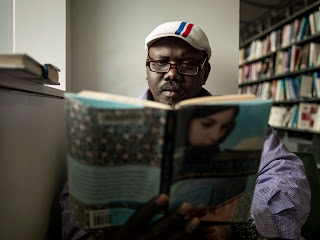___________________________________________________________________________________________________
 |
| Image 1: Picture of a homeless patron at a California library (Hoffmann) |
by Jessica Sparks
The image to the left was taken at a public library in California by National Geographic photographer, Fritz Hoffmann. It is one of many in a series from libraries in Sacramento, San Jose, and San Francisco. The caption of the image is as follows: "Khalid Elshafiea reads No God but God: The Origins and Evolution of Islam at the San Jose Public Library Central Branch. Elshafiea says that he has been homeless since 2003, when he came to the United States from Sudan" (Hoffmann).
Hoffmann began his photographic project after visiting the Sacramento Library and being stuck by the amount of homeless using the library. After that, he began to pay attention,"to change [his] perspective, to observe, to listen, to understand" (Hoffmann).
It is no surprise that libraries in cities with large populations would see a lot of homeless patrons. Libraries are there to serve the community and the homeless are part of the community. The Library is many things to those with resources at home (or a home at all): it is a safe place, it is somewhere they can be entertained, is it somewhere they can do research, and somewhere they can rest. Library computers are used to job search and write/send resumes. However, patrons who feel uncomfortable being around the homeless often voice their feelings to library staff. An article in the Library Journal "The Problem is Not the Homeless" (2011) explores how libraries can better serve the homeless by offering programs that can help foster relationships and connecting then with help they need, like social workers. The article also gives some wonderful examples of how public libraries are reaching out and taking "positive measures" to help the homeless (Lilienthal, 31). One of my favorites is a program from the District of Columbia Public Library where they matched homeless people with teen library aides:
"Using cameras, digital recorders, and journals, the teens recorded the life stories and daily experiences of these people. “Your Story Has a Home Here” was displayed in the Martin Luther King Jr. Memorial Library in downtown Washington and is available on the website at www.dclibrary.org/node/10660. Donovan believes the teens changed their opinion of the homeless. One teen aide, Miranta Clark, told a local television news station, "I thought it was their problems, like it was their fault. But after doing this project and learning some things, I actually found out that it’s not always their fault"(Lilienthal, 32).
This touched my heart and made me a little teary, not going to lie. Libraries have the power to impact one a person’s life and this is just one example! Read the full article here: http://lj.libraryjournal.com/2011/06/managing-libraries/the-problem-is-not-the-homeless/
 |
Image 2: Folks, mostly homeless men and women, line up and wait to enter the Denver
Central Library to warm up and to use their resources (Andy Cross, Denver Post)
|
The American Library Association's Social Responsibilities Round Table and Office for Literacy and Outreach Services has a toolkit for libraries on how to reduce homelessness through library engagement. The document raised some interesting points on how libraries restrict access to homeless users. One is that library card or access policies requiring a permanent address (2). It also covered some essential library services for people who are homeless such as programming, services for young people in transition, and partnerships (3-4). The American Library Association Policy Statement on Library Services to the Poor states that it is "crucial that libraries recognize their role in enabling poor people to participate fully in a democratic society, by utilizing a wide variety of available resources and strategies. Concrete programs of training and development are needed to sensitize and prepare library staff to identify poor people’s needs and deliver relevant services" (7).
Read more here: http://www.ala.org/offices/sites/ala.org.offices/files/content/olos/toolkits/poorhomeless_FINAL.pdf
__________________________________________________________________________________________________
Works Cited
Cross, Andy. “Folks, Mostly Homeless Men and Women, Line up and Wait to Enter the Denver Central Library to Warm up and to Use Their Resources.” The Denver Post, 29 Jan. 2017, www.denverpost.com/2017/01/29/homeless-assistance-denver-libraries/. Accessed 26 Apr. 2017.
Hoffmann, Fritz. “California’s Homeless Find a Quiet Place.” National Geographic, 24 Apr. 2015, proof.nationalgeographic.com/2015/04/24/public-library-portraits-californias-homeless-connect-in-a-quiet-place/. Accessed 26 Apr. 2017.
Lilienthal, Stephen M. "The Problem Is Not the Homeless." Library Journal, vol. 136, no. 11, 15 June 2011, pp. 30-34. EBSCOhost, ezproxy.palomar.edu/login?url=http://search.ebscohost.com/login.aspx?direct=true&db=aph&AN=61428299&site=ehost-live&scope=site


No comments:
Post a Comment